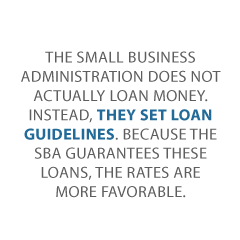Do you know the 10 things you’ll need to get a SBA loan? We break down the details and show you how to qualify for an sba loan. We have got your SBA Loan Checklist right here.
For businesses with some profitability and time in business, SBA loans are a very real possibility. Your competitions may also need to get a SBA loan, so it is better if you know before THEY do.
A Little Background on Each Type of SBA Loan
 The Small Business Administration does not actually loan money. Instead, they set loan guidelines for SBA financing. Because the SBA guarantees these loans, the rates are more favorable. The loan term is more flexible and the repayment term is good.
The Small Business Administration does not actually loan money. Instead, they set loan guidelines for SBA financing. Because the SBA guarantees these loans, the rates are more favorable. The loan term is more flexible and the repayment term is good.
But the SBA says commercial real estate investing, for example, is too high risk for them.
A lender can even be an online company, like Funding Circle. You may even fill out the SBA form loan application 100% online.
Not every company can qualify for an SBA loan. But for those that are able to, the SBA can come to the rescue and get you funding. But be aware – there is a lot of paperwork.
The Small Business Administration has the CAPLines loan program and the SBA Express Loan program. They also offer the 7a SBA loan and the 504 loan. You can even get an economic injury disaster loan.
There is also a microloan, for a lower loan amount of up to $50,000.
An SBA lending partner will actually make any given SBA loan. In addition, the SBA offers research grants if your company engages in scientific research and development.
And, the SBA has a Small Business Development Center in most major urban areas, to provide counseling and training to an entrepreneur.
SBA loan requirements differ a bit between the various SBA loan programs. However, the following SBA loan requirements are fairly universal. Beyond, of course, filling in the SBA loan application and any requested SBA form for the lender.
Note: the SBA will want to see that you have something at stake (e.g. putting in your own money, using your own credit card, or getting a personal loan).
10. A FICO SBSS of 140 or Better (ideally, over 160)
The SBA uses the FICO SBSS (Small Business Scoring Service) as a gauge of creditworthiness. The scores reflect the likelihood of an applicant paying their bills timely. This credit score ranges from 0 to 300. A higher credit score means lower risk.
Therefore, the higher the credit score you have, the better. Personal and business credit history plus financial data go into the total score calculation. They help decide if you meet eligibility requirements.
For SBA loans, you will not get an approval with a score under 140. However, they typically set a cutoff as high as 160. Below that, you will probably get a denial because of being too high a risk. They will consider this to be bad credit.
Chances are good that an SBA lender will not even submit your application to SBA if your score does not meet the threshold for credit approval.
9. Personal Credit Report
Similar to your FICO SBSS, the Small Business Administration will want to see your overall personal credit report. They want to dig beyond your numeric scores. This will help them determine your loan amount.
8. Business Credit Report
It should come as no great surprise that the SBA will want to take a close look at your business credit report as well. A PAYDEX of 80 or higher is good. Note: the range is 1 – 100.
These are the kinds of details which help the lender determine your maximum loan amount.
7. Business Plan
Every type of SBA loan program is going to want a copy of your company’s business plan. It will help the lender make decisions about your business.
A business plan will need to start with an executive summary, and a description of your business.
It should also have a market analysis designed to outline your opportunity and your competition.
Also include data about your company’s management and operations. And make sure to include the management team’s experience, and your company’s marketing and sales strategy. Finally, include your business’s financial projections and statements.
You will need to demonstrate your business’s uniqueness and also outline your financial projections. What is your company’s potential? How do you see your hoped-for loan fulfilling that potential?
6. Business Size and Time in Business
The SBA is meant for small businesses, so they want to be sure your company has less than a certain number of employees or dollars in profit. As for time in business, the SBA generally wants to see companies with at least two years in business.
5. Balance Sheet
A balance sheet is a quick snapshot of your company’s financial health. It will provide some insight into how your business functions. A balance sheet gives specifics on what you have and what you owe. It also shows a lender how you will manage your assets and liabilities.
Your assets will be anything of value that is owed or due to your business. They are the sum of: your cash, accounts receivables, notes receivables, inventory, and any company fixed asset. These can be real estate, buildings, machinery, and other items.
Your liabilities are anything the business owes. This includes accounts payable, notes payable, accrued expenses, and long-term debt.
4. Collateral
Also, you will probably have to document the value of your collateral. The amount of collateral will vary. So if other aspects of your application are strong, you might not have to put up quite so much collateral.
Collateral can come in several forms. It might be equipment or even real estate that your company owns.
3. Profit & Loss Statement (AKA an Income Statement)
A P&L (Profit and Loss statement) is, according to Investopedia:
“… [A] financial statement that summarizes the revenues, costs and expenses incurred during a specific period of time, usually a fiscal quarter or year. These records provide information about a company’s ability – or lack thereof – to generate profit by increasing revenue, reducing costs, or both. The P&L statement is also referred to as ‘statement of profit and loss’, ‘income statement,’ ‘statement of operations,’ ‘statement of financial results,’ and ‘income and expense statement.’”
A profit & loss statement shows your lender your small business’s revenues and its expenses. Your P&L will provide a degree of insight into where your money is coming from and going to. This is something both you and your lender will want to be on top of.
A strong P&L can potentially convince your lender that your cash flow is good. It can show your cash flow is steady enough to weather business downturns and to cover any unexpected costs which might potentially arise.
Creating a P&L
The P&L (AKA the income statement), one of three quarterly and annual statements a company makes as to its financial health. The other two are:
- The cash flow statement
- The balance sheet
Numerous blank P&L forms are online to help.
The idea is to show changes in accounts. This is over a specific time frame. In that way, it is similar to your cash flow statement. Contrast this with the balance sheet, which is more of a snapshot.
The Nitty Gritty of Writing a P&L
Here are specific instructions for creating a profit and loss statement, for an SBA form or any other purpose.
Net Revenue
Start with Net Revenue (the “top line”). This is the money coming in from sales. Subtract the Cost of Goods Sold. “COGS” are the hard costs associated with producing your product or service. Those can be materials, equipment, etc.
Gross Margin
Your Gross Margin is what is left, before operating expenses. Subtract your Fixed Expenses. These are fixed regular expenses like insurance and rent.
Variable Expenses
Then subtract your Variable Expenses. These are changing expenses such as travel and marketing. This is your “Earnings Before Taxes” (EBT). It is what you have before taxes are taken out.
The Bottom Line (Net Income)
Now subtract your taxes. These are expenses you have got to pay. The amount which is left over is your Net Income (the “bottom line”). This will show if your company is profitable, losing money, or breaking even.
2. Business Debt Schedule
A business debt schedule is a listing of all the debts your business currently owes. This document will also break down debt by monthly payments. It will also determine your interest rate and payment dates.
Before you take on any additional debt, you and your lender will need to consider your business debt schedule closely. This is to make sure that taking out another loan will make sense for your business. They want you to be able to pay it back.
This document will keep you organized when it comes to your business’s finances. It will help to assure that you never miss a payment. Plus you can keep track of bookkeeping and forecasting. In addition, it will help to monitor your company’s financial health.
1. Various Legal Documents
To meet SBA loan qualifications, the SBA will want to see if you have any and all business licenses you need to operate. They will also be looking for Articles of Incorporation, if applicable.
The SBA also wants to review all of your contracts with third parties. These are people such as clients or suppliers.
The SBA will want to go over any franchise agreements. They will also want to inspect any and all leases for commercial real estate or business equipment, too.
Bonus!
They also want to know the purpose of the small business loan. So what, exactly, do you want to use the financing for? Be specific on your application. The Small Business Administration wants to help you.
But they first need to know exactly where the financing is going. And they want to know what you are going to do with it. And, there are some loans where what you can do with the loan proceeds is defined by the SBA loan program itself.
SBA 504 Loan
A small business owner can use the 504 SBA loan for the purchase, development, and enhancement of commercial real estate. You can only get one by submitting a loan application to a certified development company.
You can get a 10 or a 20 year maturity period. Borrow up to $5 million.
SBA Disaster Loans
A small business owner can get an SBA disaster loan when they have suffered loss due to a declared disaster. Recently, that has included the Covid-19 pandemic.
According to the Office of the Inspector General, a lot of these payments went to ineligible recipients. As a result, the SBA will likely be cracking down on eligibility in the future.
Takeaways for the 10 Things You’ll Need to Get a SBA Loan
The Small Business Administration has rather strict SBA loan requirements. But getting everything you need, and lining all your ducks in a row, is not insurmountable. Being ready will help you get an SBA loan and also to minimize delays.
Need to get a SBA loan and find a lender? Contact us today, and we will be happy to discuss your options. And if you are finding it too hard to qualify, we can help you with Fundability™. That way, you can increase your odds of approval.
Here at Credit Suite, we can help!

